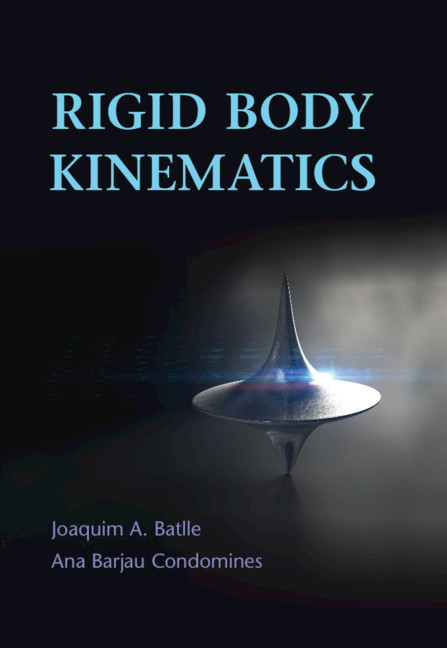
What inspired Rigid Body Kinematics?
This book is the result of a professional life devoted to Newtonian Mechanics, both from an educational and a research point of view. Early on, our lectures found their inspiration in different books in order to cover different styles (from very theoretical formulations to presentations based on particular applications). But soon we started feeling uncomfortable: no textbooks in print fully covered our syllabus, with the degree of generality and the rigor we sought, while clearly oriented toward engineering practice. So a decision was made then and there to publish internally. We created our own edition company and a set of lecture notes were updated and converted into a first textbook. More than 20 years have elapsed between that first publication and this book, a time interval that has allowed us to accumulate many exercises and to hone our presentation of applications. The result is a larger and richer version of what started as simple class notes.
What do you hope will be the lasting impact of this book?
Kinematics will always be the starting point of any mechanical study. One must be able to describe the motion of a mechanical system before addressing its redesign or the analysis of its dynamic behavior. But kinematics may also be the target of other disciplines, ranging from robotics and biomechanics to video game developers. Thus, the contents of this book will never be out-of-date!
Can you share any interesting anecdotes from the book?
Deciding to write a book is not an easy matter: it is hard work and requires discipline. In many ways it is also a deed of love, with no other reward than that which consists in completing it. But an external stimulus at the right time may be the best trigger to undertake such a task.
A few years ago, during the celebration of an academic event (that we organized and turned out to be a Newtonian theatrical fantasy with music and apples), we came across a brilliant former student that had completed his Ph.D. with us and later moved to Cambridge (UK). He congratulated us for the performance and then went directly to the point: “You should create a massive open online course (a MOOC) on Mechanics. Your style is found nowhere else. You have found a different and attractive way to present the subject, and you cannot keep that between these walls.” Our answer was clear: “No time!” But the seed was planted… And a few weeks later we were already starting to discuss the table of contents of a new book!
Why is Rigid Body Kinematics important?
This textbook covers a complete description of rigid body kinematics in 3D space. It does so in a very rigorous and precise way, yet the approach is particularly suitable for engineering students. Rigor is not at odds with the very visual and geometric approach we pursue throughout the book. We have included hundreds of original figures, conceived and drawn by one of the authors, to highlight the geometrical properties of rigid body kinematics and to help understand the concepts visually. Every single concept is illustrated through schematics and fully solved example-problems. Quite deliberately we chose to leave nothing to the reader as a further exercise! Some of the example -problems are strictly pedagogical exercises, but many others correspond to the simplified models of common mechanical systems.
We have compiled an extensive collection of multiple-choice quiz questions (with answers) and of exercises (with final results) at the end of each chapter. Quiz questions do not require long calculations, rather a clear understanding of the fundamental concepts. Exercises on the other hand are pencil-and-paper problems to be solved symbolically, because symbolic solutions allow us to detect possible errors (undetectable in numerical solutions). They also provide us with a finer-grained picture of the system behavior, (showing which parameters may be responsible for a bifurcation or transition from one regime to another).
A few puzzles complete the exercise material. They challenge the reader with formally simple systems and situations found in everyday life, whenever justifying their design and/or understanding their kinematic behavior is not intuitive, and calls for a rigorous application of the concepts introduced in the chapter.
Who is the primary audience for the book?
Our initial target was mainly undergraduate students in engineering schools, followed by those in physics. However, as we progressed in the elaboration of the book, the number of interesting applications and examples increased. The result is a longer than expected textbook, that includes more material than is likely to be covered in formal lectures to undergraduate students. It may therefore also serve as a reference for graduate students, for professional engineers working in industry, and even for researchers in robotics and biomechanics.
Widening the potential audience has been the main reason for splitting the original material into two volumes (Rigid body kinematics and Rigid body dynamics). Readers going through the first volume will achieve a deep understanding of the 3D motion of mechanical systems, going from single rigid bodies to multibody systems.
Based on your previous answer to the primary audience of the book, what are the market needs/key challenges this audience faces?
Most textbooks on Mechanics (Kinematics and Dynamics) are devoted either to simple situations (such as planar motion, far simpler than more realistic 3D motion) or to highly specialized ones (for specific branches of engineering as robotics, aeronautics, etc..). For that reason alone, they are usually not suitable reference works for engineering students or for practitioners working in industry.
Does your book solve this need/challenge? How?
This book has the right scope to cover the needs of a wide audience both in the academic and the industrial world. It guides the reader in a very progressive way without taking anything for granted (some basic mathematical concepts are explained to make the book self-contained). Every concept is explained and applied to a wide variety of situations and systems, and that makes it an excellent reference book for any university engineering program and a valuable tool for others in the field.
What unique features do you think make Rigid Body Kinematics stand out?
The main features of this textbook are its completeness, its rigor, the high number of fully solved applied problems, its extensive collection of exercises for the reader to solve, and its outstanding graphical illustration of concepts. Going through this book will help the dedicated reader acquire an in-depth knowledge and mastery of kinematics applicable to most situations.

Latest Comments
Have your say!